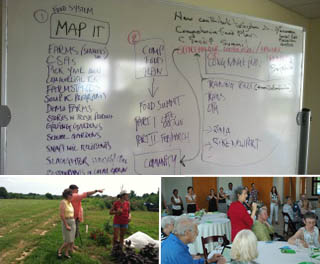
 Newport, Rhode Island—mansions, yachts, fancy shops, and upscale restaurants and 70 percent of public school students living below poverty level.
Newport, Rhode Island—mansions, yachts, fancy shops, and upscale restaurants and 70 percent of public school students living below poverty level.
A surprising dichotomy, and one indicative of another problem facing more than 150,000 Rhode Islanders—food insecurity.
In the U. S., more than 15 percent of people, almost 50 million, don’t know from where and when their next meal will come, and poverty, along with joblessness and underemployment, are among the leading causes. And those at risk are also much less likely to be able to afford fresh, locally grown, fruits and vegetables, the most important constituent in a healthy diet.
Island Commons is a group on Aquidneck Island, R. I., where Newport is the southernmost of three towns, including Middletown and Portsmouth, R. I., dedicated to creating a new food system on the island. The group, formed in 2011, aims to do this by providing a point of connection for individuals and groups interested in “the relationship between our local economy and agriculture and the health of our community,” according to Executive Director Bevan Linsley.
In 2015, the New England Grassroots Environment Fund awarded the group a Seed grant to convene stakeholders “to guide and inform the first comprehensive food plan for Aquidneck Island.” Island Commons has begun a “succession of events” they are calling “food summits” to plan and move forward on the issue.
The process began in November of 2014 with an initial gathering of 50 people “to outline a two-pronged campaign,” Linsley says, “including a platform designed to elicit political and financial support and also a ‘consciousness-raising’ campaign to help members of the community understand the short-sightedness of our current habits around food and how things might be changed for the better.”
The group held its first public event in June, attracting about 100 people; local chefs served local food (“We know serving food helps get people in the door and, after all, it is what we’re here to talk about,” Linsley says); participants heard a TED talk by Ron Finley, the “Gangsta Gardner,” engaged in public conversation, “and we got more names for our database and generated buzz and enthusiasm for the project.”
Linsley knows from long experience that avoiding the non-profit pitfall of “too much, too quickly” leading to burnout is critical. Island Commons, she says, is proceeding step-by-step. She cites the group’s initial idea of converting the St. Mary’s parish hall as a literal point of connection as a good example. “It turned out the building has just about every deferred maintenance issue a building can have, from asbestos and lead paint through plumbing problems and a bad roof,” she says. So the Grassroots Fund’s grant is helping the group’s process of planning and finding direction.
“Our October summit will be divided into two small groups, one of which will discuss community gardens, because that’s an area of need we’ve been able to identify clearly at the June meeting,” she explains. “We know that the bulk of our at-risk population, those who are truly food-insecure, live in our most urban center, Newport.
“There have traditionally been a lot of walls to community gardens there—land availability and price especially,” Linsley says. “But as a result of our second summit we have new energy to overcome some of those problems.” She notes, for instance, that the group was able to identify potential garden sites at old schools that have been closed or torn down, as well as some parcels of public land.
“In October, we will talk about what we need to make it happen” Linsley says, pointing out that the group’s new newsletter features in its first issue a “local hero” who started a community garden at the school where she teaches.
The second small group at the October summit may tackle the question of land-use policy and planning, an ongoing issue on the island, according to Linsley.
“We know we’re going to see increased pressure on what agricultural land we have on the island and we can’t afford to lose that if we’re going to improve how much of our food supply is local,” she adds.
Island Commons also received general operating support from the Kendall Foundation and was awarded funding for a “food mapping” project from the Apple Pickers Foundation, that will allow them to create “a baseline from which to build,” Linsley says. It will fund a mapping project coordinator and allows the group to receive help from a class of environmental studies students from Roger Williams University.
The mapping project identifies the status of an array of food-related issues, from land use and potential to soup kitchens and food stamps, surplus food and garden plots. It will identify needs and gaps as well as areas that need some tweaking to be more effective.
“We know, for instance, of a farmer who’s sending cabbages to a Boston food distributor only to have them trucked back to Rhode Island to be sold,” she says. “That’s the kind of opportunity for efficiency that can be identified in a mapping process and fixed with local resources.”
The point in all this, Linsley says, is to reach a goal of 50 percent of the food consumed on Aquidneck Island being produced on the island by 2060, a target of the “50 by 60” program of Food Solutions New England. “We believe we have the resources to provide healthy, local food to everyone on the island, regardless of their economic status, and we certainly know that’s a worthwhile endeavor.”
Related Groups
Related Resources
This post was originally published as a Featured Story on the New England Grassroots Environment Fund’s website.




